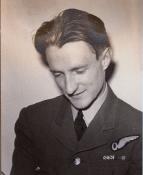
|
The King's School Canterbury |
Roll of Honour |
| Flying Officer John Custance BAKER (172487) DFC and Bar | |
|
109 Squadron Royal Air Force Date of birth: 3rd May 1921 Date of death: 10th May 1945 Killed on active service aged 24 Buried at Burnsland Cemetery Lot 137 Block 9 Section G |

|
| He was born at Penang in Malaya on the 3rd of May 1921, the youngest son of Alan Custance Baker, adviser Malayan Civil Service, and Barbara (nee Evans) of Apartment 605, 1035 Pine Street, San Francisco, California. He was educated at Hazelhurst School, Frant, and at the King's School Canterbury from September 1935 to July 1939, where he was in School House. He coxed the 2nd Boat for three years and the 1st Boat in 1939. While at school he suffered badly from asthma. On leaving school he joined the Royal Air Force as ground crew before being trained in Calgary, Canada as a navigator and flying Mosquitoes. He was commissioned as a Pilot Officer on the 25th of February 1944 and was promoted to Flying Officer on the 25th of August 1944. After flying eight missions he was paired with Flight Lieutenant John Maurice Winnington Briggs DSO DFC DFM as his pilot and together they flew 107 operations during which time Baker was awarded the Distinguished Flying Cross (London Gazette 13th of October 1944) and a Bar (London Gazette 23rd of March 1945). In December 1944 they were transferred to Transport Command to ferry Canadian built Mosquitos from Canada to England setting several speed records for the route. On account of their excellent team work they were selected to tour Canada and set out in May 1945 in Mosquito "D" for Dorothy to tour Canada on the occasion of the eighth war loan drive. The aircraft developed mechanical problems en route and they were forced to turn back to England where they were given the aircraft "F" for Freddie. "F" for Freddie (Registration BJX LR5031) was itself a veteran of 213 operational missions during the war with 105 Squadron. They landed at Calgary Airport on the 9th of May with De Havilland Engineer Edward Jack as a passenger, where they performed a spectacular display to announce their arrival. At just after 4pm on the 10th of May they took off for a flight to Red Deer and Lethridge as part of their tour with plans to return to Calgary afterwards. On departure they decided to "beat up" the control tower and made two passes at very low level impressing the crowd which had gathered to see them off. On the third pass the aircraft struck the tower and a metal pole which was used to launch weather balloons. The port wing and part of the tail plane were sheared off and the aircraft crashed, bursting into flames. Although the crew were thrown clear they were found to be have been killed. They were buried together the next day. Squadron Leader William Simpson DFC (OKS) wrote in June 1944:- "Perhaps the most important of the Met Flight's many services is its last minute report of conditions on the target before large bombing missions are made." He went on to speak of John Baker and Maurice Briggs:- "They flew together over a hundred Met Ops; throughout their long tour they worked together as a perfect team. Their flights were often eventful and dangerous, their reports terse and confined to fact" The Globe and Mail newspaper of Toronto wrote:- "When F for Freddie crashed at Calgary a deep sense of personal loss was felt by thousands. These two young men were all we always thought the ideal fliers should be, they were modest, pleasant, often gay. F for Freddie, Maurice Briggs and John Baker were the pride of a proud command. The plane itself has flown on 213 operational missions; Maurice Briggs had flown the amazing number of 145 flights, John Baker had flown 115. It was men like Maurice Briggs and John Baker who helped to save the world's freedom. That they should die now, after so many dangerous missions against the enemy, brings sorrow to a people whose hearts had been uplifted by the unconditional surrender of the foe they helped defeat." His father said:- "He was very happy, had no illusions about the dangers he was accepting, and no regrets." |
|
| School House |
Back